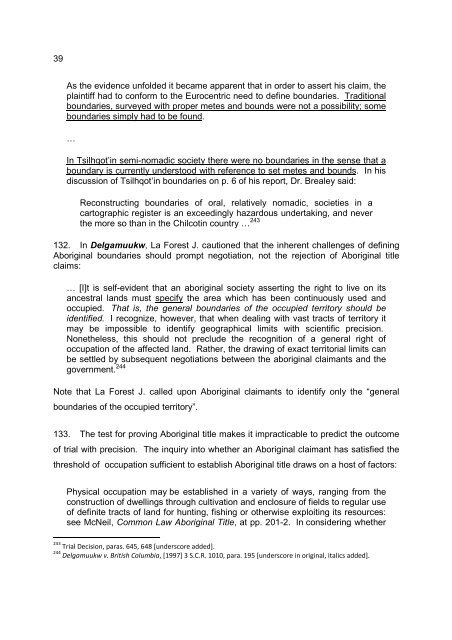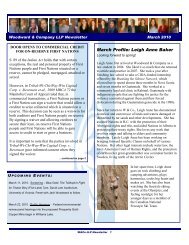38declaration should be granted”. 238 For a number of reasons, set out below, it ispractically impossible for the plaintiff to plead “every precise possible variation” 239 on theboundaries of Aboriginal title that might ultimately be proved after several years of trial.129. Yet this was the burden imposed by the Trial Judge in the court below, e.g.:If smaller definite tracts of land are to be considered, notice of such tracts shouldhave been set out in the pleadings. 240…Although British Columbia may have been aware of an alternate claim to portionsof the Claim Area, any mention of this in the statement of defence is not a defacto amendment of the plaintiff’s pleadings. More importantly, such a plea doesnot define the smaller tracts of land said to be contained within the twocomponent parts of the Claim Area”. 241130. With respect, the law cannot be that the Plaintiff is required to anticipate theoutcome of 300+ days of trial and precisely delineate, in his pleadings, the “smallerdefinite tracts of land” to which Aboriginal title will ultimately be proved. Even with thebenefit of a full trial and his own findings of fact, the Trial Judge expressed discomfortdescribing the boundaries of the Proven Title Area notwithstanding these boundarieswere “shaped by the evidence”. 242Requiring the Plaintiff to define tracts of Aboriginaltitle land with the same precision, at the pleadings stage, would impose an impossibleburden as a precondition to declaratory relief.131. This reality is underscored by the Trial Judge’s own remarks about the inherentchallenges, even with the benefit of a full trial, of drawing boundaries in Aboriginal titleclaims:238 Rt. Hon. The Lord Woolf & Jeremy Woolf, Zamir & Woolf, The Declaratory Judgment, 3 rd ed. (London: Sweet &Maxwell, 2002), p. 284.239 Lau Wing Hong & Others v. Wong Wor Hung & Another, [2006] 4 HKLRD 671, at para. 145.240 Trial Decision, para. 111 [underscore added].241 Trial Decision, para. 122 [underscore added]. See also para. 128 [“In my view, the plaintiff must make up hismind and set out in his pleadings exactly what declaration he seeks”].242 Trial Decision, para. 958 [“I acknowledge that in expressing this opinion, I am doing precisely what I wasuncomfortable with in the course of the trial, namely setting boundaries that are ill defined and not containedwithin usual metes and bounds. They are, however, boundaries that are shaped by the evidence”]
39As the evidence unfolded it became apparent that in order to assert his claim, theplaintiff had to conform to the Eurocentric need to define boundaries. Traditionalboundaries, surveyed with proper metes and bounds were not a possibility; someboundaries simply had to be found.…In Tsilhqot’in semi-nomadic society there were no boundaries in the sense that aboundary is currently understood with reference to set metes and bounds. In hisdiscussion of Tsilhqot’in boundaries on p. 6 of his report, Dr. Brealey said:Reconstructing boundaries of oral, relatively nomadic, societies in acartographic register is an exceedingly hazardous undertaking, and neverthe more so than in the Chilcotin country … 243132. In Delgamuukw, La Forest J. cautioned that the inherent challenges of definingAboriginal boundaries should prompt negotiation, not the rejection of Aboriginal titleclaims:… [I]t is self-evident that an aboriginal society asserting the right to live on itsancestral lands must specify the area which has been continuously used andoccupied. That is, the general boundaries of the occupied territory should beidentified. I recognize, however, that when dealing with vast tracts of territory itmay be impossible to identify geographical limits with scientific precision.Nonetheless, this should not preclude the recognition of a general right ofoccupation of the affected land. Rather, the drawing of exact territorial limits canbe settled by subsequent negotiations between the aboriginal claimants and thegovernment. 244Note that La Forest J. called upon Aboriginal claimants to identify only the “generalboundaries of the occupied territory”.133. The test for proving Aboriginal title makes it impracticable to predict the outcomeof trial with precision. The inquiry into whether an Aboriginal claimant has satisfied thethreshold of occupation sufficient to establish Aboriginal title draws on a host of factors:Physical occupation may be established in a variety of ways, ranging from theconstruction of dwellings through cultivation and enclosure of fields to regular useof definite tracts of land for hunting, fishing or otherwise exploiting its resources:see McNeil, Common Law Aboriginal Title, at pp. 201-2. In considering whether243 Trial Decision, paras. 645, 648 [underscore added].244 Delgamuukw v. British Columbia, [1997] 3 S.C.R. 1010, para. 195 [underscore in original, italics added].
- Page 1 and 2: JUN 04 * u|UCOURT OF APPEALCourt of
- Page 3 and 4: C. Alternative Argument: The Trial
- Page 5 and 6: DateDecember 18,1998October 14,1999
- Page 7 and 8: OPENING STATEMENT1. The Tsilhqot’
- Page 10 and 11: 2then Chief of the Xeni Gwet’in,
- Page 12 and 13: 414. The Tsilhqot’in people inhab
- Page 14 and 15: 6… [T]he proper rights holder, wh
- Page 16 and 17: 8F. Tsilhqot’in Territory and the
- Page 18 and 19: 10bounding the Claim Area. For them
- Page 20 and 21: 12…I am satisfied Tsilhqot’in p
- Page 22 and 23: 1452. The Trial Judge summarized th
- Page 24 and 25: 16records document numerous situati
- Page 26 and 27: 18days, Tsilhqot’in warriors also
- Page 28 and 29: 20declaration because of the manner
- Page 30 and 31: 22• On the west, from Xeni across
- Page 32 and 33: 24part of their oral traditions, pr
- Page 34 and 35: 26declaration of title in accordanc
- Page 36 and 37: 28would have cross-examined witness
- Page 38 and 39: 30circumstances of the case, which
- Page 40 and 41: 32111. In a subsequent motion, the
- Page 42 and 43: 34by the evidence, then the Court c
- Page 44 and 45: 36exactly what declaration he seeks
- Page 48 and 49: 40occupation sufficient to ground t
- Page 50 and 51: 42(a) The Plaintiff was not require
- Page 52 and 53: 44process and the legal requirement
- Page 54 and 55: 46157. Proof of an ancestral and mo
- Page 56 and 57: 48uncertainty”. 272 The meaning o
- Page 58 and 59: 50therefore, of opinion, that all n
- Page 60 and 61: 52land regularly used by the Tsilhq
- Page 62 and 63: 54stated that it depends on the fac
- Page 64 and 65: 56the lands in question. At common
- Page 66 and 67: 58193. Moreover, the Trial Judge’
- Page 68 and 69: 60PART 4 - NATURE OF THE ORDER SOUG
- Page 70 and 71: 62R. v. Marshall; R. v. Bernard, [2



